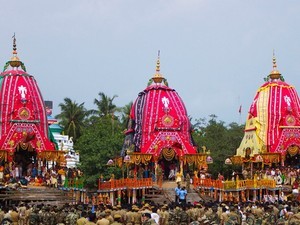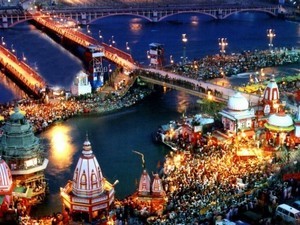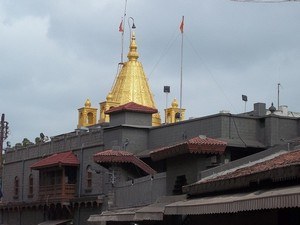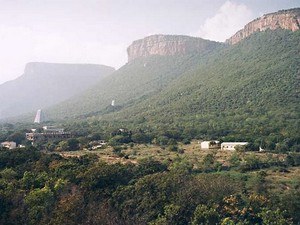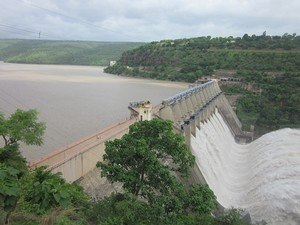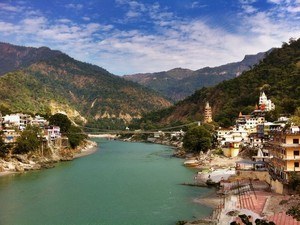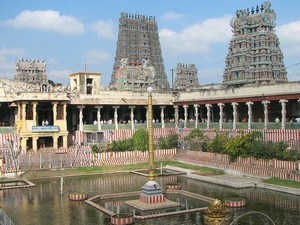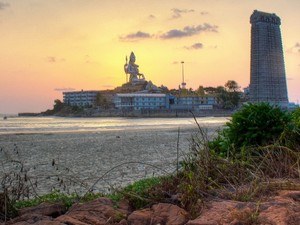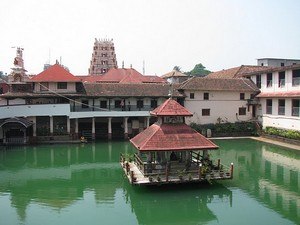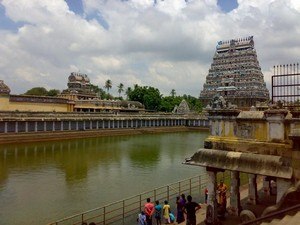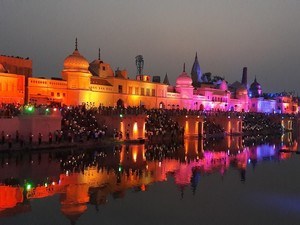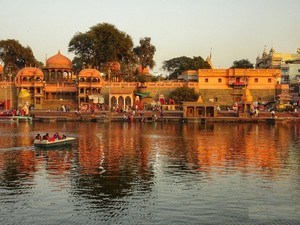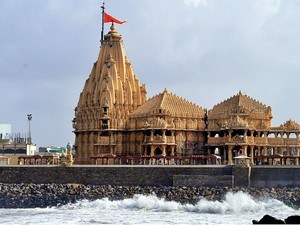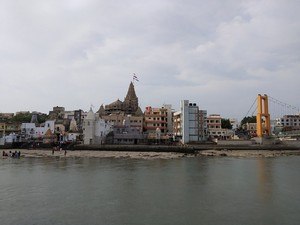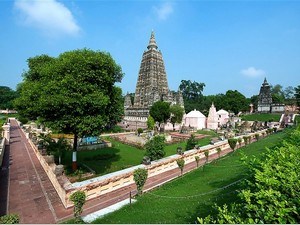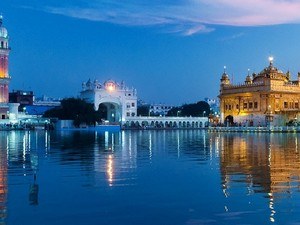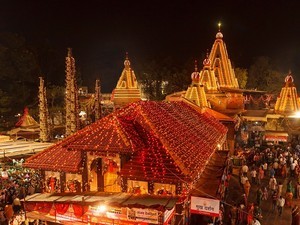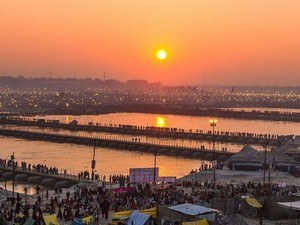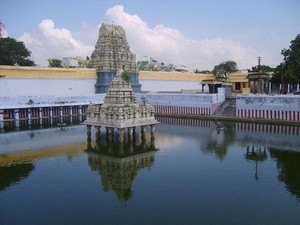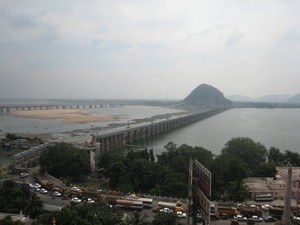1
DAY 1 : VARANASI SIGHTSEEING
DAY 1 : VARANASI SIGHTSEEING
 Sightseeing
Sightseeing
Leisure / No Sightseeing
About Kashi Vishwanath Temple / Golden Temple
At a distance of 5 Km from Varanasi Junction, Kashi Vishwanath Temple is an ancient Hindu temple situated on the banks of River Ganga in Varanasi city of Uttar Pradesh. Kashi Vishwanath Temple is dedicated to Lord Vishwanath, one of the incarnations of Lord Shiva and he is regarded as the patron deity of Varanasi. Popularly known as Golden Temple, it is one of the twelve jyotirlinga temples of Lord Shiva, and also one of the popular
pilgrimage sites in India. The temple was visited by many great saints including Ramakrishna Paramhansa, Swami Vivekananda, Maharishi Dayanand Saraswati, Goswami Tulsidas, Adi Shankaracharya and Gurunanak Dev. Lord Vishwanath is considered to the supreme origin of the spiritual truth and strengthens the bonds of universal brotherhood. It is believed that a single darshan of Vishweshwara Jyotirlinga is considered to auspicious more than the darshan of other .....
 Duration of visit: 1 Hour
Duration of visit: 1 Hour
 Timings: 4 AM to 11 PM
Timings: 4 AM to 11 PM
About Annapurna Devi Mandir
At a distance of 5 Km from Varanasi Junction, Annapurna Devi Mandir is a popular Hindu temple situated near Kashi Vishwanath Temple in Vishwanath Galli area of Varanasi, Uttar Pradesh. The temple is dedicated to Goddess Annapurna Devi, the Goddess of Food or the Goddess of Nourishment. It is believed that Goddess Parvati gave Alms to Shiva, and she is depicted with a bowl in one hand and ladle in the other, serving food to Shiva, standing in front of her with his begging bowl in the hand. Mata Annapurna is the Goddess of Varanasi who always protects Kashi and feeding her devotees. Having great religious importance in Hinduism, it is one of the must-include places in the
Varanasi pilgrimage packages.
History & Mythology of Annapurna Devi Mandir
Annapurna Devi Mandir was constructed by Maratha Peshwa Baji Rao in 1729 AD. According to the legend, the entire world .....
 Duration of visit: 30 Mins
Duration of visit: 30 Mins
 Timings: 4 AM to 10 PM
Timings: 4 AM to 10 PM
About Manikarnika Ghat
At a distance of 1 Km from Dasashwamedh Ghat and 6 Km from Varanasi Junction, Manikarnika Ghat is one of the holiest ghats along the banks of River Ganga in the sacred city of Varanasi. Situated just beside Dasashwamedh Ghat, it is the main cremation ghat in Varanasi, and among the most famous places to visit as part of the
Varanasi leisure tours. The Manikarnika Ghat is perpetually bustling with ceremonies and rituals, with pyres burning round the clock, and it is a poignant place where life and death intersect visibly. According to the religious beliefs, burning the dead bodies at this ghat is a way to attain Moksha, the salvation.
History of Manikarnika Ghat
The Manikarnika Ghat is vividly depicted in the Kashi Khanda and is commonly referred to as Mahashmashana, the grand cremation ground. Additionally, this ghat is mentioned in a Gupta inscription dating back to the .....
 Duration of visit: 30 Mins
Duration of visit: 30 Mins
 Timings: 24 Hours
Timings: 24 Hours
At a distance of 1 km from Dasashwamedh Ghat and 5 km from Varanasi Junction, Lalita Ghat is one of the main ghats on the Ganges River in Varanasi. This ghat is one of the most venerated ghats of Kashi for the devotees and is also identified among the seven most prominent ghats of Varanasi by Varanasi Tourism Department.
The ghat was built by King of Nepal, Rana Bahadur Shah in the early 19th century CE. The ghat is dedicated to Lalita Devi who is reckoned to be the personification of Goddess Durga. Devotees who come to this ghat believe that bathing at this ghat will earn the blessings of the Goddess.
Lalita Ghat is dotted with several Hindu temples. The well-known 'lingam' of Ganga Keshav and shrines of Gangatitya, Kashi Devi, Lalita Devi and Bhagirath Tirtha are affiliated to Lalita Ghat. Also known as Nepali Mandir, the Keshava temple was built by King of Nepal in typical Nepalese architecture. Also known as Kothwala Temple, thi is the replica of the famous Pashupatinath .....
 Duration of visit: 30 Mins
Duration of visit: 30 Mins
 Timings: Nepali Temple: 4 AM - 9 PM
Timings: Nepali Temple: 4 AM - 9 PM
BREAK FOR MEALS / HOTEL CHECK-IN | CHECK-OUT / SHOPPING / LEISURE
About Sri Kasi Vishalakshi Devi Temple
At a distance of 5 Km from Varanasi Junction, Sri Kashi Vishalakshi Temple is a Hindu temple situated at Mir Ghat on the banks of the Ganges at Varanasi in Uttar Pradesh, India. The temple is dedicated to Goddess Vishalakshi Devi, the divine form of Goddess Sati. This temple is one among the 51 Shakti Peethas, and is part of the famous triad of temples- Kanchi Kamakshi, Madurai Meenakshi and Kashi Vishalakshi. Situated near Kashi Vishwanath Mandir, it is among the popular temples in Uttar Pradesh, and also one of the must visit places as part of the
Varanasi family packages.
History & Mythology of Sri Kasi Vishalakshi Devi Temple
The Sri Kashi Vishalakshi Devi Temple was established and is preserved by the Nattukottai Nagarathar, a trading community originating from Tamil Nadu. The temple's narrative is closely linked to the tale of Sati, the daughter of .....
 Duration of visit: 30 Mins - 1 Hr
Duration of visit: 30 Mins - 1 Hr
 Timings: 4.30 AM - 11 AM & 5 PM - 10 PM
Timings: 4.30 AM - 11 AM & 5 PM - 10 PM
About Dasashwamedh Ghat
At a distance of 6 Km from Varanasi Junction, Dasashwamedh Ghat is a sacred ghat on the banks of River Ganga in the holy town of Varanasi. Located close to Vishwanath Temple, Dasashwamedh Ghat is the main ghat in Varanasi, and also one of the popular places to visit as part of the
Varanasi luxury tours. This is also the busiest ghat. On the tenth waxing fortnight of the Jyeshtha (May/June) worship of the Ganga is celebrated on a grand scale in the Ganga temple at the top of the ghat. Dashashwamedh Ghat is a popular destination for pilgrims and tourists who come to witness the sacred rituals, take part in boat rides, and soak in the spiritual ambiance of Varanasi.
History & Mythology of Dasashwamedh Ghat
Dashashwamedh Ghat is translated as the 'Ghat of Ten Horses.' This name originates from an ancient legend in which Lord Brahma conducted a ten-horse sacrifice, known as .....
 Duration of visit: 30 Mins - 1 Hr
Duration of visit: 30 Mins - 1 Hr
 Timings: 24 Hours, Ganga Aarti: 6.30 PM
Timings: 24 Hours, Ganga Aarti: 6.30 PM
2
DAY 2 : VARANASI SIGHTSEEING
%%Itinerary_Title_Day2%%
About New Vishwanath Temple / Birla Temple
At a distance of 12 Km from Varanasi Junction, New Vishwanath Mandir, also known as Birla Temple is a Hindu temple situated in the premises of Banaras Hindu University (BHU) in Varanasi. Dedicated to Lord Shiva, it is one of the popular temples in Banaras and also one of the biggest tourist attractions that one must visit as part of the
Varanasi tour packages. The temple is colloquially called VT, an acronym of Vishwanath Temple. The temple is under direct administration of the Banaras Hindu University.
History of New Vishwanath Temple / Birla Temple
The original Kashi Vishwanath Temple was destroyed by multiple invaders; however, the locals supported by their Hindu patrons reconstructed this ancient temple as many times. Hence, Pandit Madan Mohan Malaviya decided to replicate Sri Kashi Vishwanath Mandir in the campus of Banaras Hindu University. The Birla family .....
 Duration of visit: 30 Mins
Duration of visit: 30 Mins
 Timings: 4 AM - 12 PM & 1 PM - 9 PM
Timings: 4 AM - 12 PM & 1 PM - 9 PM
At a distance of 11 km from Varanasi Junction, Bharat Kala Bhavan Museum is an art and archeological museum located within the campus of Banaras Hindu University, Varanasi. It is one of the oldest museums in India and also one of the important places to visit in Varanasi.
Bharat Kala Bhavan Museum was established in 1920 AD. From 1920 to 1962, the museum was shifted to several locations within Varanasi. Pandit Jawaharlal Nehru laid the foundation of the existing museum building in 1950 and the museum was shifted to its existing location in 1962. Rabindranath Tagore was its first honorary chairman. However the full credit for its development and upgradation goes to late Rai Krishnadasa who was a renowned Hindi writer and a great pioneer.
The museum holds more than 100,000 memorable collections of artifacts. These artifacts are displayed in different galleries namely Mahamana Malaviya Gallery, Nicholas Roerich Gallery, Chhavi or Painting Gallery, Sculpture Gallery, Nidhi or Treasure .....
 Duration of visit: 30 Mins - 1 Hr
Duration of visit: 30 Mins - 1 Hr
 Timings: 10 AM to 5.30 PM, Closed on Saturday, Sunday and University Holidays
Timings: 10 AM to 5.30 PM, Closed on Saturday, Sunday and University Holidays
At a distance of 2 km from Assi Ghat and 8 km from Varanasi Junction, Sankat Mochan Hanuman Temple is a sacred temple on the banks of River Assi in Varanasi of Uttar Pradesh. Situated near Durgakund Temple, it is one of the holy temples in Kashi and also one of the top places to visit in Varanasi.
Sankat Mochan Hanuman Temple is one of the revered temples of Lord Hanuman in the city of Varanasi. The word Sankat Mochan means deliverer from troubles. Sankat Mochan Temple was founded by Tulsidas, author of the Ramcharitmanas. It was constructed in 1900s by Pandit Madan Mohan Malviya (founder of BHU). It is believed that temple has been built at the very spot where the saint Tulsidas had a vision of Lord Hanuman.
According to Vedic Astrology, Lord Hanuman protects his devotees from the anger of planet Saturn and those who have ill placed Saturn in their horoscope visit Sankat Mochan Temple to get remedy. The laddu offered at this temple is essentially famous among the locals. .....
 Duration of visit: 30 Mins
Duration of visit: 30 Mins
 Timings: 5 AM to 10 PM
Timings: 5 AM to 10 PM
At a distance of 7 km from Varanasi Junction, Tulsi Manas Mandir is a Hindu temple situated next to the famed Durgakund Temple in Varanasi, Uttar Pradesh. It is one of the most famous temples of Varanasi and also an important tourist attraction of the holy city.
Tulsi Manas Mandir was built in the year 1964 by Seth Ratan Lal Sureka of Bandhaghat (Howrah). Named after saint Tulsidas, the temple has been precisely devoted to Lord Rama. This temple has great historical and cultural importance in Hinduism since the ancient Hindu epic Ramcharitmanas was originally written at this place by Hindu poet-saint, reformer and philosopher Goswami Tulsidas in the 16th century CE.
The temple was constructed in white marble with beautiful landscaping all around. The walls of the temple are engraved with scenes from Ramcharitmanas, the Hindi version of Ramayana. The temple has beautiful images of the Ram, Sita, Lakshmana and Hanuman. There is an attractive Tulsi Garden which has very calm .....
 Duration of visit: 15 Mins
Duration of visit: 15 Mins
 Timings: 5 AM - 12 PM & 4 PM - 9 PM
Timings: 5 AM - 12 PM & 4 PM - 9 PM
At a distance of 7 km from Varanasi Junction, Durga Mandir or Durgakund Temple is a prominent Hindu temple situated near Tulsi Manas Temple in Varanasi. It is one of the popular places of pilgrimage in Banaras and also one of the must visit Varanasi Tourist Places.
Dedicated to Goddess Durga, Durga Mandir was built in the 18th century by a Bengali Maharani. According to the legend, the idol in the temple is not made by man but appeared on its own. It is believed that Goddess Durga has protected Varanasi for many centuries from the South. The temple is known with the name of monkey temple as tourists can spot number of monkeys in the temple vicinity.
The temple was built in Nagara style of architecture. The temple is painted red with ochre to match the colours of the central icon of Durga, the goddess of strength and power. The temple is made up of many small sikharas adjoined together. The temple is located on the banks of a rectangular tank, which is often called as the Durga .....
 Duration of visit: 15 Mins
Duration of visit: 15 Mins
 Timings: 4 AM - 1 PM & 3 PM - 8 PM
Timings: 4 AM - 1 PM & 3 PM - 8 PM
At a distance of 3 km from Dasashwamedh Ghat and 8 km from Varanasi Junction, Assi Ghat is one of the famous ghats on the banks of River Ganga in Varanasi. Situated at the confluence of Ganga and Assi Rivers, it is the southernmost ghat in Kashi and also one of the important Places to visit in Varanasi.
Assi Ghat has numerous references in the early literature of the Hindus including Agni Purana, Matsya Purana, Padma Purana, Kurma Purana and Kashi Khand. According to the mythology, Goddess Durga had thrown her sword in Assi River after killing the demons Shumbha & Nishumbha. Assi Ghat is called as Assi Saimbeda Tirtha in Kashi Khand and is one of the five special ghats visited by pilgrims during the Panchtirtha Yatra.
Also known as Asi Ghat, the Ghat is renowned for a large Shiva Lingam placed under a Peepal Tree. This place also boasts one more ancient temple enshrining a Shiva Lingam famously known as Asisangameshwar Lingam. This was also the place where the renowned saint .....
 Duration of visit: 30 Mins
Duration of visit: 30 Mins
 Timings: 24 Hours
Timings: 24 Hours
3
DAY 3 : SARNATH & RAMNAGAR FORT SIGHTSEEING
%%Itinerary_Title_Day2%%
 Sightseeing
Sightseeing
At a distance of 2 km from Sarnath Railway Station, and 8 km from Varanasi Junction, Chaukhandi Stupa is an ancient monument located in the heart of Sarnath. It is one of the notable monuments of the Buddhist culture, and among the must include places in Sarnath Tour Packages.
Chaukhandi Stupa is the first monument to encounters as one enters Sarnath. This ancient Buddhist site has evolved from burial mounds and served as a shrine for a relic of Buddha. Originally, the Chaukhandi Stupa has been built as a terraced temple during the Gupta period between the 4th and 6th centuries to mark the site where Lord Buddha first met a group of five ascetics to whom he later went on to preach his first teachings. Later Govardhan, the son of a Raja Todar Mal, the governor under Emperor Akbar, modified the stupa to its present shape in the year 1588 CE to commemorate the visit of Emperor Humayun to Sarnath.
It is a lofty mound of brickwork whose square edifice is surrounded by an octagonal .....
 Duration of visit:
Duration of visit:
 Timings:
Timings:
At a distance of 1 km from Chaukandi Stupa, 1.5 km from Sarnath Railway Station, and 9 km from Varanasi Junction, Dhamek Stupa, also spelled Dhamekh and Dhamekha, is a massive stupa located at Sarnath in the state of Uttar Pradesh, India. Within the complex of Archaeological Remains of Sarnath, it is one of the popular Buddhist monuments in Sarnath and among the must-visit places as part of Varanasi Tour Packages.
Dhamek Stupa is one of the most important sights in Sarnath as it marks the exact spot where Lord Buddha preached the first sermon to His five disciples after attaining enlightenment in Bodh Gaya. In several of the ancient sources, the site of the first sermon is mentioned to have been at a ??Mriga-Dayaa-Vanam?? or a sanctuary for animals. After the parinirvana of Lord Buddha, his mortal remains were cremated and the ashes divided and buried under eight mounds with two further mounds encasing the urn and the embers. Little is known about these early stupas, particularly .....
 Duration of visit:
Duration of visit:
 Timings:
Timings:
At a distance of 1.5 km from Sarnath Railway Station, and 9 km from Varanasi Junction, Archaeological Buddhist Remains or Monastery Ruins is an excavated site in Sarnath. Just Beside Archaeological Museum, it is one of the popular archaeological sites in India, and among the must-visit Sarnath Tourist Places.
The Archaeological Remains of Sarnath started attracting the scholars since the 19th Century. As a result excavation works of Sarnath started first of all by Sir Alexander Cunningham (1835-36), Major Kittoe (1851-52), Mr. C. Horne (1865), Mr. F.O. Oertal (1904-05), Sir Johan Marshal (1907), Mr. H. Hargreaves (1914-15), Mr. Daya Ram Shani (1927-32). Then after a gap of about 82 years once again excavation work is conducted by Sarnath Circle, Sarnath of Archaeological Survey of India.
The colossal ruins lie in the same compound as Dhamek Stupa. The excavation sites of Sarnath have impressive collections of monasteries, stupas, temples, inscriptions, sculptures, and other .....
 Duration of visit:
Duration of visit:
 Timings:
Timings:
At a distance of 500 m from Dhamek Stupa, 1.5 km from Sarnath Railway Station, and 9 km from Varanasi Junction, Archaeological Museum is a museum located in Sarnath. Just beside the Archaeological Remains Complex, it is one of the popular museums in Varanasi, and among the top places to visit in Sarnath.
Popularly called as Sarnath Museum, the Archaeological Museum in Sarnath was established in the year 1910 CE by Sir John Marshall, the then Director-General of Archaeology in India. It was constructed just adjacent to the excavated site at Sarnath to keep the antiquities found from the site. The museum building was started in 1904 and was completed in 1910. It is the oldest site museum of the Archaeological Survey of India. As the findings are mostly from Buddhist monasteries or vihar, the plan of the building was designed by James Ransome on the pattern of a Sangharam or a vihar. The whole building is made of sandstone with a flat roof.
The museum contains five galleries .....
 Duration of visit:
Duration of visit:
 Timings:
Timings:
At a distance of 1.5 km from Sarnath Railway Station, and 9 km from Varanasi Junction, Wat Thai Sarnath Temple is a Buddhist temple in Sarnath. Situated near Archaeological Museum, it is one of the popular Buddhist temples in Sarnath and among the prominent places to visit in Sarnath.
Popularly known as the Thai Temple, Wat Thai Sarnath Temple was built by Thai dignitaries in the year 1933. Adorned with manicured gardens, the Thai Temple is built in the Thai architectural style and is managed by Thai Buddhist Monks. Just before the entrance of the main temple, there are images of laughing Buddha along with an enactment of Lord Buddha delivering a sermon to his disciples. Another statue of Lord Buddha in Bhumisparsha mudra can be seen in the temple.
An important highlight of the Thai Temple in Sarnath is the 80-foot tall image of Buddha in a standing position. The construction of the statue is said to have taken more than a decade. There are running fountains with blooming lotus .....
 Duration of visit:
Duration of visit:
 Timings:
Timings:
At a distance of 1 km from Sarnath Railway Station, and 9 km from Varanasi Junction, Tibetan Temple is a Buddhist monastery and temple located in Sarnath, Uttar Pradesh. It is one of the popular Buddhist temples in Sarnath and among the prominent places to visit in Sarnath as part of the Buddhist Pilgrimage Tour in India.
Built-in 1955, Tibetan Temple is one of the highly revered places of pilgrimage in Sarnath. The Tibetan temple is presently under the administration of Lhadhan Chotrul Monlam Chenmo Trust. Built-in a traditional Tibetan architectural design, the temple includes some striking features. The entrance of the temple is guarded and beautifully adorned with intricate carvings of two lions. Inside the large open compound, one can see a light pink stupa built by the Tibetans to show their gratitude to the Indian Government for giving asylum to the fleeing Dalai Lama. It also denotes to pay tribute to all those who died in the freedom struggle of Tibet and those who continue .....
 Duration of visit:
Duration of visit:
 Timings:
Timings:

